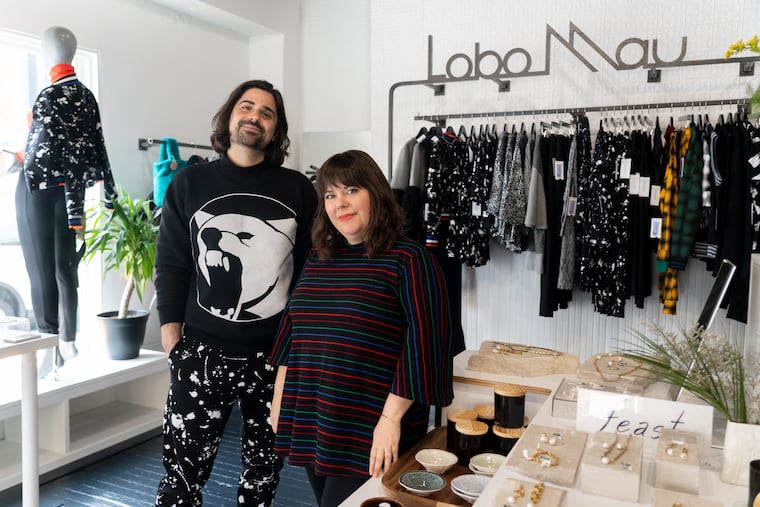Why Lobo Mau designer Nicole Haddad is betting sustainable fashion has a future in Philadelphia | Elizabeth Wellington
The bulk of Lobo Mau's merchandise hails from designer Nicole Haddad’s clothing line that isn't just cute but is made with as much respect for the environment as Haddad can muster.

As I walked through Nicole and Jordan Haddad’s two-week-old clothing and lifestyle boutique, Lobo Mau, it became clear to me what slow and sustainable fashion really is.
In the far left corner of the 800-square-foot, gender-inclusive store was a selection of funky coats and jackets from upcycled brand Paulo Redeem, designed by charter school vice principal Naa Amerley Badger. Badger uses parts of used clothing — say the waistband on a pair of jeans — and fashions them into outer garments. Odabu candles, poured by queer barber Billy Green, are made of a wax that doubles as a body balm, which you can use as the candle melts. And, in the display windows are snazzy totes and backpacks from the Los Angeles-based brand Rewilder, made from recycled air bags.
But the bulk of the boutique’s merchandise hails from Nicole Haddad’s 12-year-old unisex clothing line, Lobo Mau. It isn’t just cute and comfy — I’m still thinking about a pair of paint-splattered ponte pants — it’s made with as much respect for the environment as Haddad can muster. And then some.
“The idea of making a product and not knowing how it affects the world just doesn’t make sense to me," Haddad told me Wednesday afternoon. This is why Haddad uses dead stock fabric — bolts of fabric that are either damaged or left over ― to make her collection’s signature tunics, jumpsuits, sweatshirts, and joggers. She tries to use only recycled nylon for the striped ribbing on the sleeves of her sweatshirts.
Hadadd screenprints her designs on fabrics only a few blocks away in her Bok Building studio. And her entire collection, which ranges from XS to 2X, is cut and sewn in Port Richmond, minimizing the carbon footprint. (Because the collection is made from start to finish in Philadelphia, it doesn’t have to travel far, so it uses less greenhouse gases than something made overseas.)
“I don’t know why people aren’t more passionate about how they leave this world,” Haddad, 39, said.
Sustainable fashion and its close cousin, slow fashion, are among the industry’s biggest buzzwords as brands — and celebrities — try to prove to us how good they are. There isn’t much difference between the two, but sustainable fashion, no matter how big the brand, emphasizes eco-friendly practices (such as using organic cotton or natural dyes). Slow fashion means moving away from mass production, preferring smaller batches and handmade pieces, (which is also better for the environment, and the people who make the clothes).
During last Sunday’s Oscars red carpet, a number of actresses called attention to the sustainable attributes of their frocks. Actress Saoirse Ronan went for a black and lavender Gucci gown made from material repurposed from her BAFTA gown from the week before. And Kaitlyn Dever wore a custom-made “sustainable” gown by Louis Vuitton made from eco-responsible silk satin.
Exactly what made the satin in Dever’s Louis gown eco-responsible, she didn’t say. And it’s these kinds of claims that makes some of us wary of the sustainable fashion movement. How do we really know that brands from Louis and Gucci to H&M and Forever 21 are really practicing sustainability and not just claiming to be eco-friendly — also known as “greenwashing”?
“Look at the brand’s carbon footprint,” Haddad said. Do they make clothing overseas and have it shipped here? The bigger the brand, the more that’s likely to go to waste. “That is why we make small batches. We test products and see if they will sell. That way we don’t have as much overstock." Less overstock means less chance of the extras ending up in landfills.
Nicole Haddad has been designing clothing since she was a little girl. When she visited Brazil, where her dad is from, she’d ask the seamstresses who lived across from her grandmother’s house to bring her designs to life. She studied art history at Skidmore College in upstate New York and went on to get a master’s in fashion design in 2008. After graduation, she launched Lobo Mau — which means “bad wolf" in Portuguese. “I didn’t want my ideas to be swamped by a bigger company. I wanted to be bold so I started the brand with the fun energy of the ’80s and ’90s.”
In 2011, she began sharing a space with Lele Tran in Old City’s now-defunct US*U.S. Co-op. (Tran is turning the space into a cafe.) Haddad was one of the early designers featured in Ethan Nguyen’s store, now called M Concept. Last year, Haddad launched a Kickstarter with her brother, 31-year-old businessman Jordan Haddad, to open their own store. The goal was $20,000, but they raised $27,000 when it was all said and done.
“People we hadn’t seen in years contributed," said Jordan Haddad, channeling ’80s Wham vibes in his feathered hair and Lobo Mau printed joggers. “It’s a testament that people really want to become a national brand that will help in making ethical fashion the norm.”
Lobo Mau is located at 700 S. Sixth St., 215-238-2129.